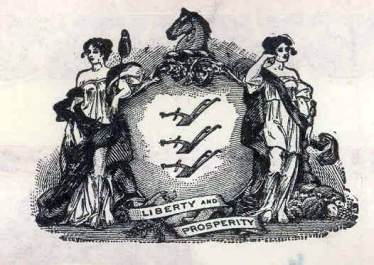Beautifully engraved certificate from the City of Jersey City General Improvement Bond issued in 1923 and 1925. This historic document was printed by the Hamilton Banknote Company and has an ornate border around it with a vignette of the state seal. the 1925 Bond says "General Improvement Gold Bond" and the 1923 says "General Improvement Bond" on its face. This item is hand signed by the City's Mayor, Director of the Department of Revenue and Finance and Clerk is over 90 years old. 
Certificate Vignette Frank Hague was born, January 17, 1876 and died, January 1, 1956. Born in Jersey City, Hudson County, N.J. Uncle of Frank Hague Eggers. Born in Jersey City, Hudson County, N.J., January 17, 1876. Democrat. Mayor of Jersey City, N.J., 1917-47; delegate to Democratic National Convention from New Jersey, 1932. Catholic. Powerful leader of Hudson County Democratic "machine". Indicted for various crimes but never convicted. Died, from complications of bronchitis and asthma, in New York, New York County, N.Y., January 1, 1956. Interment at Holy Name Cemetery, Jersey City, N.J. "I am the law." Those words defined Mayor Frank Hague's reign as absolute ruler of Jersey City. A product of grinding poverty who was expelled from school by age thirteen, Hague built a political juggernaut whose influence reached beyond the governor's mansion to the White House. In the soiled history of New Jersey politics, populated with plenty of ne'er-do-wells, Hague's legend stands out. He reformed the police department to his liking and kept the mob out of his fiefdom. Pandering to workers' distrust of big business, he tried to impose huge tax hikes on local companies. Yet he often battled the Congress of Industrial Organizations, which he called a den of Communists. Repeated investigations of City Hall corruption never resulted in his indictment. In 1932 Hague delivered so many votes for FDR that the President funneled millions from the Works Progress Administration to help build Roosevelt Stadium and Jersey City Medical Center. Though Hague's official salary never topped $7,500, he lived in sumptuous style, often making voyages to Europe. Besides a fourteen-room apartment in Jersey City, he owned homes in Florida and Manhattan and a $125,000 mansion in Deal. At 71, likely tiring and sensing his support slipping, he resigned as mayor and, with a kingmaker's arrogance, appointed as his successor his own nephew. Jersey City (1990 pop. 228,537), seat of Hudson co., NE N.J., a port on a peninsula formed by the Hudson and Hackensack rivers and Upper New York Bay, opposite lower Manhattan; settled before 1650, inc. as Jersey City 1836. The second largest city in the state and a commercial and industrial center surpassed only by Newark, it is a port of entry and a manufacturing center. With 11 mi (17.7 km) of waterfront and significant rail connections, Jersey City is an important transportation terminal point and distribution center. It has railroad shops, oil refineries, warehouses, and plants that manufacture a diverse assortment of products, such as chemicals, petroleum and electrical goods, textiles, and cosmetics. The city has benefited from its position across from the island of Manhattan, and many Jersey City companies are extensions of those originating in New York City. Further developments have included increased housing and shopping areas; other parts of the city, however, remain run-down after years of commercial activity. A large number of various ethnic groups, particularly Hispanics and Indians, live in family housing developments. The city has a modern medical center and is the seat of Jersey City State College and St. Peter's College. In Lincoln Park is a statue of Lincoln, built in 1929. Liberty State Park, on the waterfront, is the site of a science museum and provides an excellent view of New York harbor.The area was acquired by Michiel Pauw c.1629. The Dutch soon set up the trading posts of Paulus Hook, Communipaw, and Horsimus. In 1674 the site fell permanently under British rule. The fort at Paulus Hook was captured by Light-Horse Harry Lee under Washington's plan, Aug. 19, 1779. Nearby Bergen was a stockaded Dutch village dating from before 1620 and had New Jersey's first municipal government, church (Dutch Reformed), and school (1662). Jersey City was consolidated with Bergen and Hudson City in 1869; the town of Greenville was added in 1873. The city's industrial growth began in the 1840s with the arrival of the railroad and the improvement of its water transport system. In 1916, Jersey City docks were the scene of the Black Tom explosion that caused widespread property damage.The city has benefited from its position across from the island of Manhattan, and many Jersey City companies are extensions of those originating in New York City. Further developments have included increased housing and shopping areas; other parts of the city, however, remain run-down after years of commercial activity. A large number of various ethnic groups, particularly Hispanics and Indians, live in family housing developments. The city has a modern medical center and is the seat of Jersey City State College and St. Peter's College. In Lincoln Park is a statue of Lincoln, built in 1929. Liberty State Park, on the waterfront, is the site of a science museum and provides an excellent view of New York harbor.

Certificate Vignette














